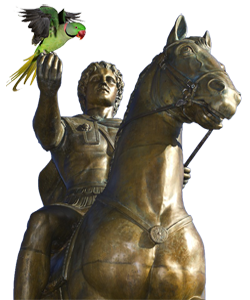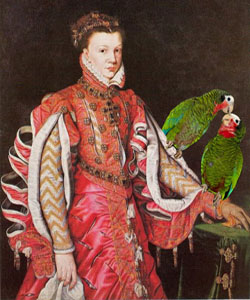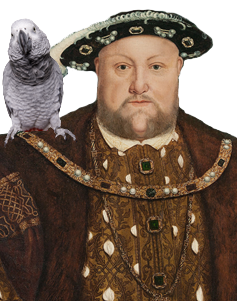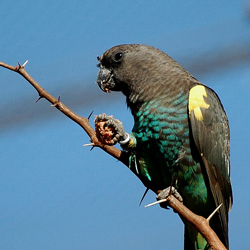|
  
The beauty, social nature, intelligence and talking ability of parrots has long fascinated humans. Historical records indicate that parrots and other birds with the capacity to talk (mynahs, starlings, ravens) have been kept as pets dating back to the ancient Egyptian, Greek and Roman cultures.
- Ancient Egyptian hieroglyphics from 4000 years ago depict what appear to be pet birds.
- In ancient Greece, the mynah was kept among the aristocracy as a pet, and in India, the mynah has been considered sacred for more than 2,000 years, and during a feast day, individual birds were carted through the city by oxen.
- The earliest known reference to a parrot in European literature is dated 397 BC, and is found in Ctesia's work Indica in which the author provides a description of what is now known as a plum-headed parakeet. He described a bird that could speak an "Indian" language.
- Aristotle (385-322 BC) described a bird which he called Psittacae whose name was the basis for the scientific name for the parrot family – Psittacine.
- The Alexandrine Parakeet is named for Alexander the Great brought parrots to Europe from India with specimens of parrots around 327 B.C.
- In ancient Rome, pet parrots were considered luxuries by wealthy Romans and they were often housed in cages made from precious metals, tortoise-shell and ivory. Unfortunately, parrots were also considered a delicacy during this time. The Romans introduced parrots to much of the rest of Europe and trade in parrots became a regular business.
- Archaeologists have determined that Native American tribes in the Southwest were involved in the trade of parrots. Parrot's remains discovered in the Chaco Canyon area suggests trade with Mexico and the ancient Toltecs (850 – 1120 AD).
- In the Middle Ages, parrots were owned by the wealthy. They were valued by rulers such as Holy Roman Emperor Frederick II (1194-1250), whose favorite was an Umbrella cockatoo that was given to him by the Sultan of Babylon.
- Parrots were often kept by royalty and even Pope Martin V (1417-1431) appointed a Keeper of Parrots at the Vatican. Reportedly, there is a room at the Vatican named "Camera di Papagallo" – the Parrot's room (from the habit of popes keeping a parrot there).
- In 1493, Columbus returned to Spain from the New World with a pair of Cuban Amazons as a gift for Queen Isabella. With the discovery of the New Worlds, the trade in live parrots expanded.
- It is told in some journals of Spanish generals, that tame parrots kept by Caribbean Islanders warned at least one native village of the approach of Spanish conquistadors allowing the villagers' time to escape into the jungle.
- In the sixteenth Century, Henry VIII of England kept an African grey parrot at Hampton Court. (1509-1547) that reportedly amused itself by calling the boatman from across the water to the Palace who then had to be paid for their efforts.
- The Duchess of Richmond and Lennox was buried in Westminster Abbey in 1702 with her beloved parrot.
- Pirates and Parrots?
By the time of the Golden Age of Piracy (1680 – 1730) there was a well established trade in parrots. Usually animals aboard a ship were used as provisions rather than as pets but fortunately parrots weren't a favorite meal. It is thought that the pirate & parrot cliché originated from Robert Louis Stevenson's "Treasure Island". However, the historical journal of Pirate Captain William Dampier describes that in certain cases pirates actually did take parrots on board, most likely because they wanted to sell them at a profit to the high society of Europe. In Dampier's journal it is mentioned that parrots were stored along with other animals and provisions on the ship, while anchoring at a Caribbean island:
"The tame Parrots we found here were the largest and fairest Birds of their kind that I ever saw in the West Indies. Their colour was yellow and red, very coursly mixt; and they would prate very prettily; and there was scarce a Man but what sent aboard one or two of them. So that with Provision, Chests, Hencoops and Parrot-Cages, our Ships were full of Lumber, with which we intended to sail."
- Other famous bird owners of the time included: Marie Antoinette 1755-1793 (African Grey) and Wolfgang Amadeus Mozart 1756-1791 (Starling). When Mozart's pet starling died, he held a parody funeral attended by mourners who sand hymns and listened to a poem composed by Mozart fondly in his birds' honor:
A little fool lies here
Whom I held dear—
A starling in the prime
Of his brief time
Whose doom it was to drain
Death's bitter pain.
Thinking of this, my heart
Is riven apart.
Oh reader! Shed a tear,
You also, here.
He was not naughty, quite,
But gay and bright,
And under all his brag
A foolish wag.
This no one can gainsay
And I will lay
That he is now on high,
And from the sky,
Praises me without pay
In his friendly way.
Yet unaware that death
Has choked his breath,
And thoughtless of the one
Whose rime is thus well done.
- Queen Victoria (1837-1901) had an African Grey that sang "God Save the Queen".
- What about birds in the White House? In the early days of the republic, birds were popular First Pets.
- Martha Washington, wife of our 1st President, George Washington (1789-1791), had a parrot "Polly" who George supposedly didn't like. It is said that both George and the parrot kept a close eye on each other when they were in the same room.
- Thomas Jefferson (1801 – 1809) had a mockingbird that was trained to ride on his shoulder and take food from his lips.
- Dolly Madison, wife of James Madison (1809-1817), had a green parrot that was rescued from the White House when it was burned during the War of 1812.
- Andrew Jackson (1829-1837) owned a parrot "Pol" that was taught to curse in both Spanish and English. A story has been told that the parrot attended Jackson's funeral, where it disrupted the service with a loud string of profanity.
- Zachary Taylor (1849 - 1850) had a canary named "Johnny Ty".
- Ulysses S. Grant's (1869-1877) son had a pet parrot.
- Rutherford Hayes (1877-1881) kept canaries.
- Grover Cleveland's (1885-1889 and 1893-1897) wife Frances had both canaries and mockingbirds.
- William McKinley (1897-1901) had a Double Yellow Amazon named "Washington Post"
- Theodore Roosevelt (1901-1909) had a Blue & Gold Macaw " as well as a Hyacinth Macaw named "Eli Yale".
- Warren Harding (1921-1923) kept canaries.
- Calvin Coolidge (1923-1929) had canaries named "Nip," "Tuck," and "Snowflake" as well as a mockingbird.
- John F. Kennedy (1961-1963) had parakeets named "Bluebell" and Marybelle" as well as a canary named "Robin".
- Lyndon B. Johnson (1963-1969) had lovebirds.
- Did you know that parrots played an important role in WW I? In Paris, they had parrots man a post on top of the Eiffel Tower where, due to their incredible sense of hearing, they could detect and warn of the approach of enemy aircraft long before any human ear could hear them.
- In WW II, Churchill kept company with a Blue & Gold Macaw named Charlie. As of an article written in 2004, Charlie was still alive at the ripe old age of 104. The article stated that Charlie can still be coaxed to repeat favorite sayings, such as "[expletive] Hitler" and "[expletive] the Nazis." Update: although this has been a popular fun "fact" it has recently been disputed by Churchill's daughter, The Lady Soames. In a letter she stated " My father never owned a Macaw in the 1930s or at any other time as far as I am aware. He did own an African Grey Parrot in the mid to late Thirties. I do not know how he acquired it. I cannot remember the parrot's name; it was quite disagreeable and frequently bit those who tried to curry favour with it."
|









































































